Deep beneath the ocean’s surface, where sunlight barely penetrates, an extraordinary natural phenomenon occurs. Some marine creatures have evolved the remarkable ability to produce their own light—a process known as bioluminescence. Among these living light sources, one species stands out as the brightest animal on Earth: the crystal jellyfish (Aequorea victoria).
This translucent umbrella-shaped invertebrate isn’t just a beautiful example of nature’s ingenuity; it has also revolutionized biological research and medical science. In this exploration of the ocean’s living light show, we’ll discover how these creatures illuminate the depths, why they evolved this dazzling ability, and how humans have learned to harness their glow for scientific breakthroughs.
The Crystal Jellyfish: Earth’s Brightest Living Light

The unassuming crystal jellyfish (Aequorea victoria) holds the distinction of being the brightest bioluminescent animal known to science. Native to the Pacific Ocean off the west coast of North America, this transparent jellyfish measures only about 10 centimeters in diameter when fully grown. What makes this creature extraordinary is not just its ability to produce light but the remarkable efficiency with which it does so.
The crystal jellyfish contains special photoprotein cells around its bell margin that, when triggered, create a vivid blue-green light visible even in the darkest ocean depths. Scientists have measured its bioluminescent efficiency at nearly 100%, meaning almost all the energy in the chemical reaction is converted to light rather than heat—making it the most efficient light-producing system known in nature or developed by humans.
Understanding Bioluminescence: The Chemistry of Living Light

Bioluminescence occurs when energy is released by a chemical reaction involving a light-emitting molecule called luciferin and an enzyme called luciferase. In the crystal jellyfish, the process involves a photoprotein called aequorin that contains both the luciferin (known as coelenterazine) and luciferase-like components. When calcium ions bind to aequorin, it triggers the oxidation of coelenterazine, releasing energy in the form of blue light.
The crystal jellyfish also possesses a green fluorescent protein (GFP) that absorbs this blue light and re-emits it as green light—a process that became the foundation for one of biology’s most important research tools. This chemical process is remarkably efficient, with the crystal jellyfish converting nearly all the chemical energy into light without wasting it as heat, which is why its bioluminescence is so bright and pure.
The Revolutionary Discovery of Green Fluorescent Protein

In 1962, scientist Osamu Shimomura was studying the crystal jellyfish when he isolated a protein that glowed bright green under ultraviolet light. This protein, later named Green Fluorescent Protein (GFP), would go on to revolutionize biological and medical research. The significance of this discovery was recognized with the 2008 Nobel Prize in Chemistry, shared by Shimomura, Martin Chalfie, and Roger Y. Tsien. GFP’s greatest value comes from its ability to be attached to other proteins without disrupting their function, essentially creating a visible tag that allows scientists to track proteins in living cells. This breakthrough has enabled countless advances in understanding cellular processes, disease mechanisms, and developmental biology. The crystal jellyfish’s bright light has quite literally illuminated our understanding of life at the molecular level.
Ecological Role: Why the Crystal Jellyfish Lights Up

The crystal jellyfish didn’t evolve its remarkable bioluminescent abilities to aid human research—this adaptation serves critical ecological functions. Scientists believe the jellyfish’s light-producing capability primarily works as a defense mechanism. When disturbed or attacked by a predator, the jellyfish can produce a bright flash, startling the attacker or potentially attracting larger predators that might threaten the original attacker—a strategy known as the “burglar alarm” effect.
Additionally, the distributed pattern of light around its bell margin may confuse predators about the jellyfish’s actual size and location. Some researchers also theorize that the bioluminescence might aid in attracting the tiny planktonic organisms that the jellyfish feeds on, though this remains under investigation. These ecological advantages explain why natural selection has favored the development and refinement of such an energy-intensive adaptation.
Beyond the Crystal Jellyfish: Other Brilliant Marine Luminaries
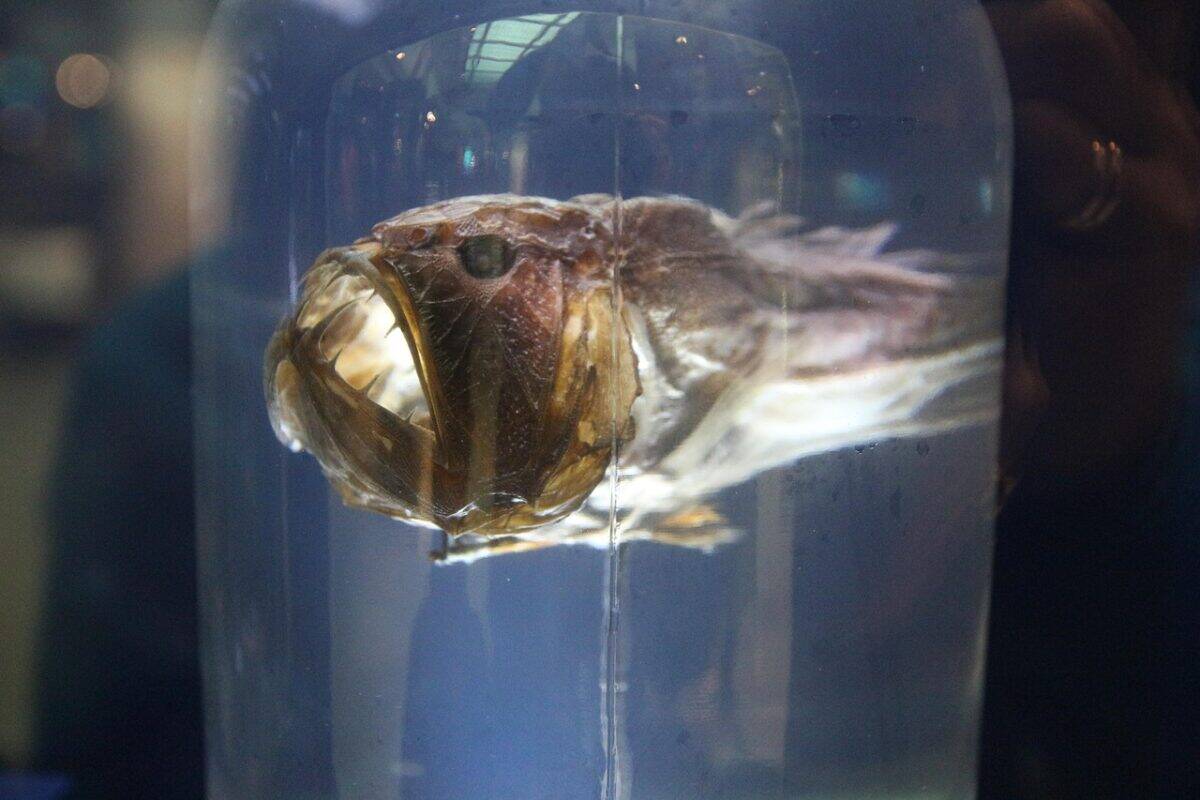
While the crystal jellyfish may be the brightness champion, it has impressive competition throughout the ocean depths. The flashlight fish (Anomalops katoptron) harbors bioluminescent bacteria in special organs beneath its eyes, which it can reveal or conceal with a lid-like mechanism, creating a blinking effect used for communication and hunting.
The Hawaiian bobtail squid (Euprymna scolopes) maintains a symbiotic relationship with bioluminescent bacteria that fill a special light organ on its underside, creating a form of counter-illumination camouflage that eliminates its shadow when viewed from below. Deep-sea anglerfish females dangle bioluminescent lures containing symbiotic bacteria to attract prey in the lightless depths. Perhaps most spectacular are the displays of dinoflagellates—microscopic plankton that, when agitated, create the “sea sparkle” phenomenon where breaking waves or swimming fish leave trails of blue light in their wake. Each of these organisms has evolved its own unique approach to living light.
The Depths of Darkness: Where Bioluminescence Thrives

The prevalence of bioluminescence increases dramatically with ocean depth, and this is no coincidence. In the mesopelagic zone (200-1,000 meters deep), often called the “twilight zone,” sunlight has mostly disappeared, creating the perfect environment for living light to evolve as a survival advantage. In these depths, an estimated 90% of marine organisms possess some bioluminescent capability.
Even deeper, in the bathypelagic zone (1,000-4,000 meters), where sunlight never penetrates, bioluminescence becomes one of the primary sources of light. The crystal jellyfish typically inhabits the upper mesopelagic zone, where its bright emissions can stand out against the faint remnants of filtering sunlight. This environmental pressure explains why the most efficient and brightest bioluminescent systems have evolved in marine environments rather than on land, where alternative visual communication methods remain effective.
Measuring Brightness: How Scientists Quantify Bioluminescence

Determining which marine organism produces the brightest bioluminescence requires sophisticated measurement techniques. Scientists use specialized instruments called luminometers and photomultiplier tubes to detect and quantify the photons emitted during bioluminescent reactions. Brightness is typically measured in units called quanta per second, representing the number of photons emitted.
The crystal jellyfish’s photoprotein aequorin has been measured to emit approximately 10^9 (one billion) photons per second when activated—an extraordinarily high output. Additionally, researchers assess quantum yield—the efficiency with which chemical energy converts to light energy—and the crystal jellyfish approaches nearly 100% efficiency, compared to standard incandescent light bulbs that typically operate at only 10% efficiency. These measurements confirm that the crystal jellyfish’s bioluminescent system remains unmatched in its brightness and efficiency among known organisms.
Bioluminescence vs. Biofluorescence: Understanding the Difference
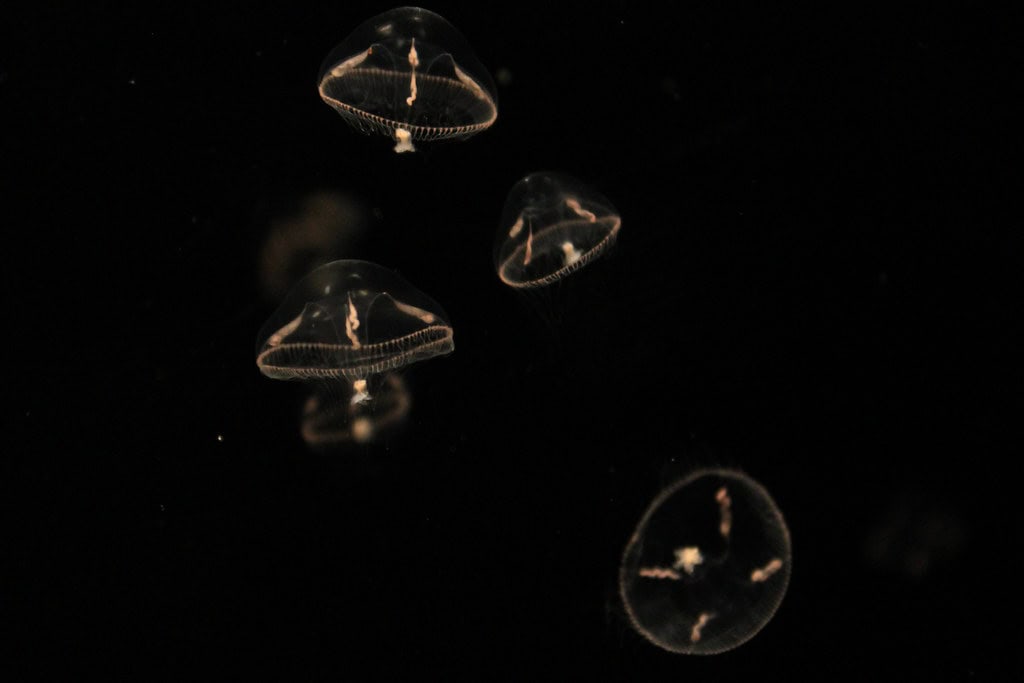
The marine world features two distinct light-producing phenomena that are often confused: bioluminescence and biofluorescence. Bioluminescence, exemplified by the crystal jellyfish’s aequorin system, involves the production of light through chemical reactions without requiring external light input. In contrast, biofluorescence—also present in the crystal jellyfish through its Green Fluorescent Protein—occurs when organisms absorb light of one wavelength and re-emit it at a longer wavelength, typically shifting blue light to green, yellow, or red. Many coral reef inhabitants, including certain fish, corals, and anemones, are biofluorescent rather than bioluminescent.
The crystal jellyfish is unique in that it employs both processes: its aequorin system produces blue bioluminescent light, which is then absorbed by GFP and re-emitted as green fluorescent light. This combined system creates the jellyfish’s characteristic bright green glow, demonstrating the sophisticated light-manipulation capabilities that have evolved in marine environments.
Medical Breakthroughs: How the Brightest Animal Helps Human Health
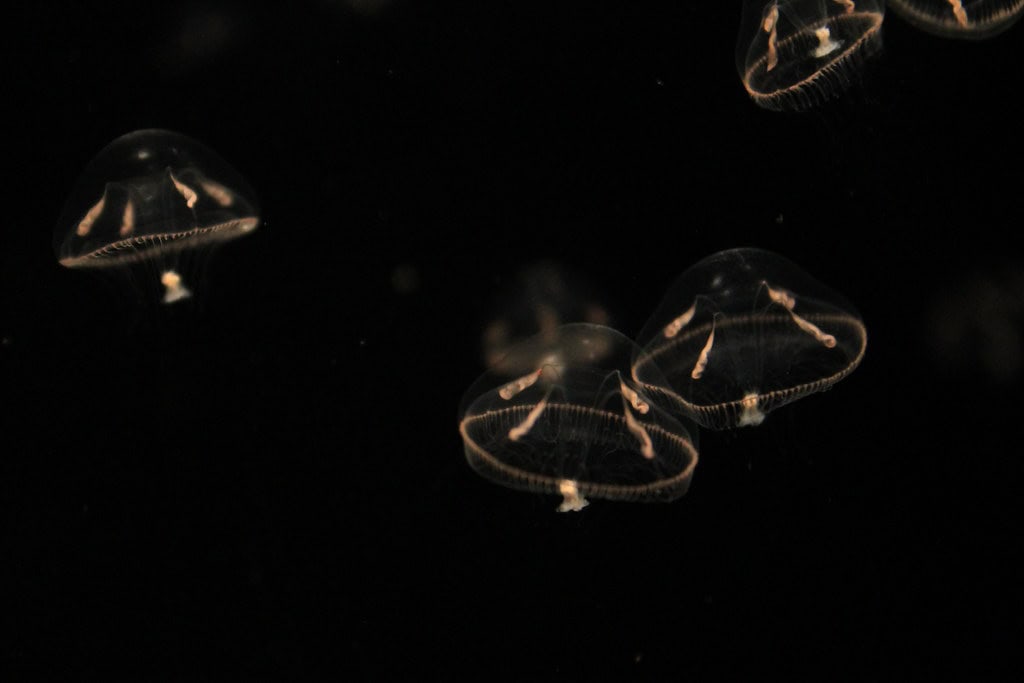
The crystal jellyfish’s bioluminescent system has led to revolutionary applications in medical research and clinical practice. Beyond GFP’s use as a cellular marker, researchers have developed calcium-sensitive aequorin-based tools that allow real-time visualization of calcium signaling in cells—crucial for understanding neurological processes and cardiac function. Bioluminescence imaging (BLI) techniques derived from marine bioluminescent systems enable non-invasive monitoring of cancer progression, infection spread, and drug effectiveness in living experimental animals.
In the field of disease diagnostics, bioluminescent proteins are used to detect specific biomarkers in blood samples, enabling faster and more sensitive tests for conditions ranging from viral infections to cancer. Perhaps most promising is the emerging field of optogenetics, where light-sensitive proteins are used to control specific cells in the brain, offering potential treatments for conditions like Parkinson’s disease, epilepsy, and blindness. The medical applications continue to expand as researchers find new ways to harness the crystal jellyfish’s remarkable light-producing capabilities.
Conservation Concerns: Protecting Living Light
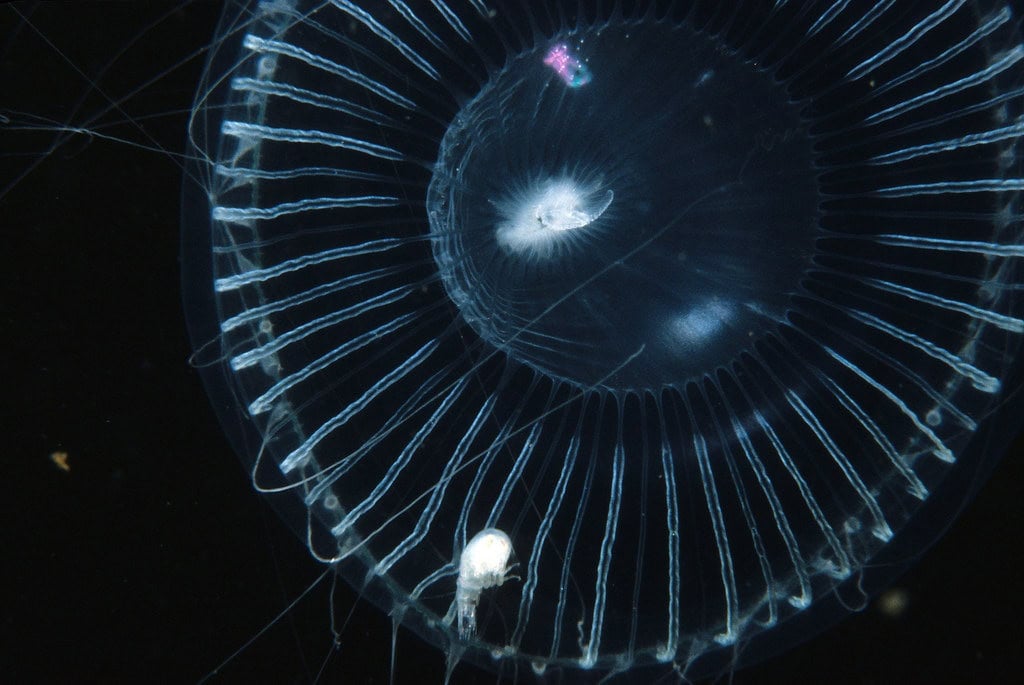
Despite their scientific importance, crystal jellyfish and other bioluminescent marine organisms face growing threats from human activities. Ocean warming due to climate change disrupts the delicate temperature ranges these species require, potentially altering their distribution patterns or reproductive cycles. Ocean acidification—caused by increased atmospheric carbon dioxide dissolving into seawater—may affect the chemical reactions underlying bioluminescence in unpredictable ways.
Light pollution from coastal development can disrupt the natural light patterns that bioluminescent organisms have evolved to complement. While the crystal jellyfish is not currently considered endangered, its populations have not been comprehensively assessed. Conservation efforts for marine bioluminescent species include marine protected areas in regions with high bioluminescent diversity, reduced coastal light pollution initiatives, and ongoing research to monitor population trends and understand how environmental changes might affect these remarkable light-producing organisms.
Harnessing Bioluminescence: Future Applications

The crystal jellyfish’s efficient light-producing system continues to inspire innovative applications beyond medicine. Engineers are developing bioluminescent plants that could one day serve as sustainable lighting solutions, potentially reducing electricity consumption. Military and security applications include developing “glow in the dark” markers using engineered bioluminescent proteins that require no external power source. Environmental scientists are exploring bioluminescent biosensors that change brightness in response to specific pollutants, creating living environmental monitoring systems.
Perhaps most futuristically, some researchers envision bioluminescent urban trees that could illuminate sidewalks and parks without electricity. There’s even research into creating bioluminescent fabrics for clothing and accessories. These applications represent a growing field called “living light technology” that seeks to harness and adapt the remarkable efficiency of natural bioluminescent systems like that of the crystal jellyfish to create sustainable alternatives to conventional lighting and sensing technologies.
Observing Bioluminescence: Where and How to Witness Nature’s Light Show
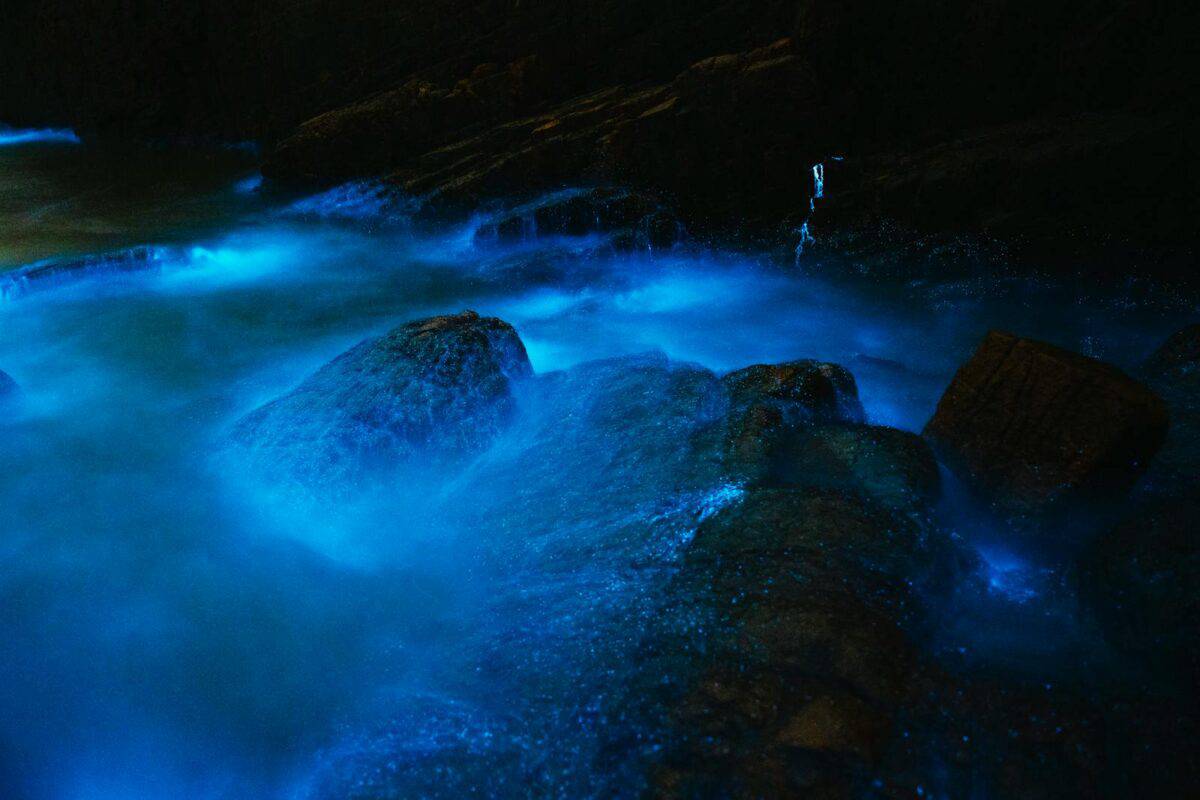
For those inspired to witness bioluminescence firsthand, several global hotspots offer spectacular displays. Puerto Rico’s Mosquito Bay, Jamaica’s Luminous Lagoon, and the Maldives’ Vaadhoo Island feature dinoflagellate-rich waters where simply moving through the water at night creates waves of blue light. The crystal jellyfish itself can occasionally be observed along the Pacific coast from California to Alaska, though specialized nighttime diving is typically required. For a more accessible experience, many public aquariums have created dedicated bioluminescence exhibits with special darkened viewing areas.
The Monterey Bay Aquarium in California and Ripley’s Aquarium in Canada feature interactive displays that allow visitors to trigger bioluminescent reactions. Photographers hoping to capture bioluminescence should use cameras with excellent low-light capabilities, tripods for stability during long exposures, and visit during moonless nights when natural bioluminescence appears brightest against the dark background. Whether observed in the wild or in controlled environments, witnessing this living light creates a profound connection to one of nature’s most magical phenomena.
Illuminating Conclusions: The Significance of the Ocean’s Living Light

The crystal jellyfish stands as a remarkable testament to the ingenuity of natural selection, having evolved the brightest and most efficient light-producing system known on our planet. From the depths of the Pacific Ocean, this unassuming creature has not only mastered the chemistry of living light but has unknowingly provided humanity with tools that have transformed our understanding of biology and medicine.
The story of the crystal jellyfish reminds us that some of our most significant scientific breakthroughs come from unexpected sources—in this case, a delicate, transparent invertebrate that evolved to illuminate the ocean depths. As we continue to explore and protect our oceans, we may yet discover more living light sources with capabilities we cannot yet imagine, further expanding the remarkable legacy of the brightest animal on Earth.
- The Real Wildlife Behind the Great American Road Trip - August 10, 2025
- Top Volcano Trails Where You Might Spot Rare Wildlife - August 10, 2025
- The Magic Fish That Grants Wishes in European Fairy Tales - August 10, 2025

